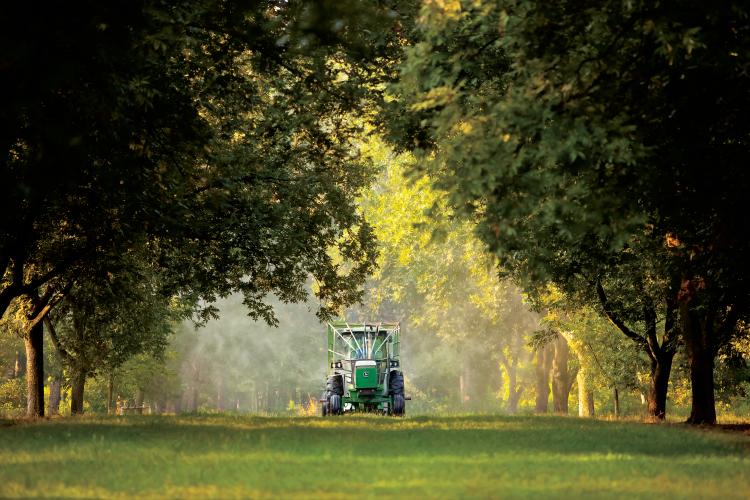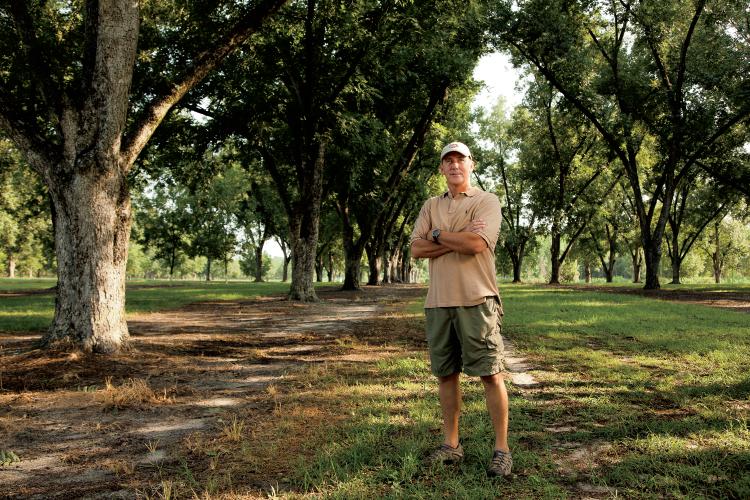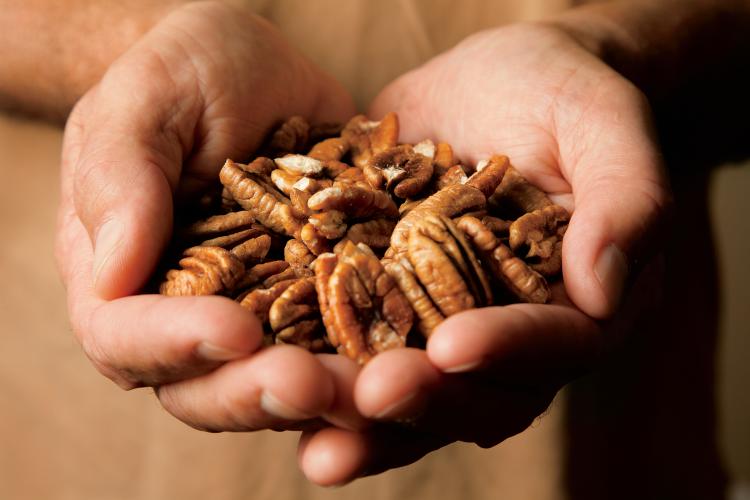Home > Georgia > Georgia Crops & Livestock > Shake and Shell: Georgia is a Top Pecan Producer
Shake and Shell: Georgia is a Top Pecan Producer

There’s nothing that says Southern hospitality quite like a homemade pecan pie. And no place grows more of the tasty nut that goes into that sweet treat than Georgia.
Each year, 1,000 farmers grow nearly 100 million pounds of pecans on more than 400,000 acres of Georgia farmland, which translates to between $250 and $300 million in farm gate value annually.
That’s one small nut making one big difference in the agricultural economy of the state.
Whole Lot of Shakin’ Goin’ On
Greg Leger has been in the pecan business all his life, working first with his father and now overseeing the production of 275 acres of pecan trees in Cordele. Some are newly planted, while others are more than 60 years old. Leger explains that it’s important to have trees of varying ages because older pecan trees tend to have less consistent production.

“The industry is beginning to understand that older, larger trees have to exert themselves much more, so they tend to alternate bear, with a heavy crop one year followed by a lesser crop the next,” says Leger.
To manage that variability, Leger selectively plants new trees, which will not produce pecans for six to seven years. However, by the time the trees are 15 to 20 years old, they could be producing about 100 pounds of pecans each, he says. That’s a lot of pecan pies.
From the budding of the pecan trees in May through the end of the growing season in September, Leger tends to the proper watering, fertilization and pest management of the orchards. In October, the harvest begins. You don’t pick pecans from the trees, explains Leger. You shake them out.
“We’ll get 40 to 50 percent of the pecans out of the trees with mechanical tree shakers. Then, after a freeze, when most of the foliage is off the trees, we’ll come back and shake them again because the mechanical shakers don’t work as well with all the leaves on.”
This two-part process allows the grower to get the benefits of early market prices that tend to be higher. It can take Leger two weeks to harvest all his acres on the first pass. Then he’ll wait two to three weeks before taking the second pass to complete the harvest. Leger also cleans the pecans, packs them in big supersacks and then sells them to brokers. His operation doesn’t include shelling the pecans.

“Shelling is a much different game,” says Leger. “You have to have a lot of volume to make it financially beneficial to shell.”
That’s where the 10 shellers in the state come in. Before 1920, consumers removed the shells themselves by hand after they bought the pecans. But with the development of commercial shelling equipment, pecan-lovers could put away their nutcrackers.
According to the National Pecan Shellers Association, since the 1950s more than 80 percent of pecans have been sold with the shell removed. Large pecan plants can have as many as 14 cracking machines with a capacity of 150,000 pounds a day and 30 million pounds each season. Some shelling plants operate all year, while others operate only during the fall harvest season.
After the pecans are shelled, they are packed in cans, jars or bags to protect them from humidity, light and other factors. They are shipped to retail, food-service or commercial markets.
Exporting Taste and Nutrition
Recent research on the nutritional benefits of pecans has increased their popularity with the consumer. That research shows pecans to be a heart-healthy, cholesterol-lowering, nutrient-dense snack and a great natural source of fiber, protein, and antioxidants.

The American consumer isn’t the only one recognizing the taste and nutritional value of the pecan. The export market is growing as well, especially for pecans that remain in the shell. China is a big buyer of Georgia pecans, as are several other Asian countries. According to the Georgia Pecan Growers Association, nearly one-third of the pecan crop was exported in 2011 and nearly half the crop produced the year before.
“The export market has the largest impact on the growth of the industry for both growers and shellers,” says Vickie Mabry of the National Pecan Shellers Association. “And it shows continued promise for both shelled and in-shelled products sold.”




How much do the pecan shakers getboer tree to shake the trees and what is the name of the business that does the shaking